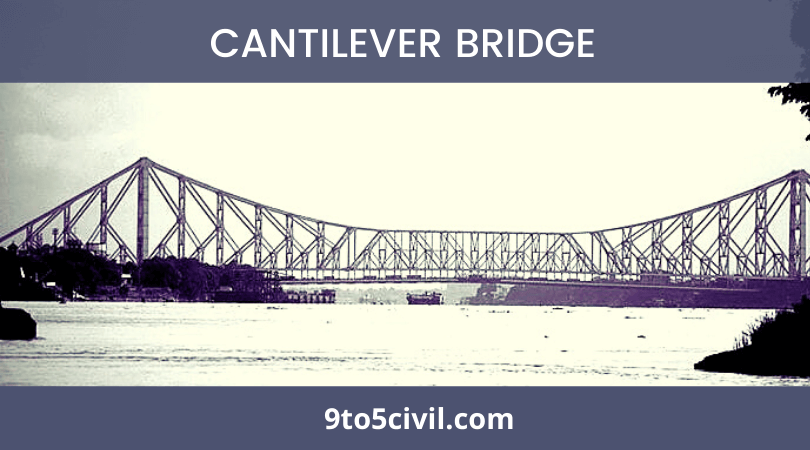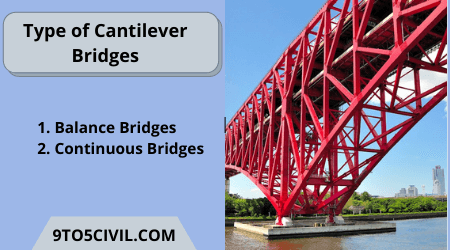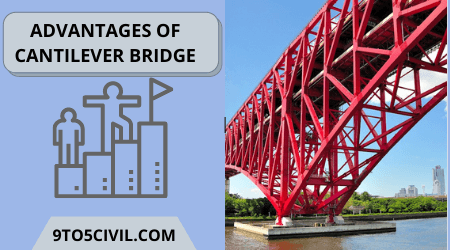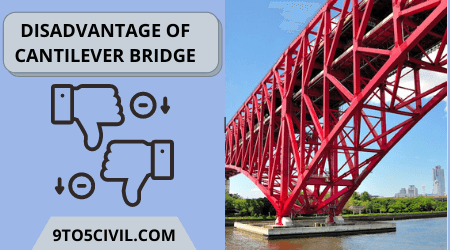
Introduction of Cantilever Bridge
The cantilever bridge is a type of bridge. The feature of a cantilever bridge is that it has support on one end and the other end is free.
The first most modern cantilever bridge was built in 1867 in Germany up to 124 feet (38 m) in the middle of the Hassfurt Bridge over the main river.
The most famous cantilever bridge is the Forth Rail Bridge. The bridge holds the 17-year record for having the longest span in the world.
In this post, you will learn about cantilever bridges, types of cantilever bridges, and the advantages and disadvantages of cantilever bridges.
Also Read: What Is a Beam Bridge? | Types of Beam Bridges | Advantage & Disadvantage of Beam Bridge
What Is a Cantilever Bridge?
Cantilever bridges are primarily designed to handle situations such as road or railway traffic. The cantilever bridge is usually made of structural steel or Prestressed Concrete.
A cantilever bridge is a structure in which one part acts as an anchor to support the other part. In this type of bridge, a portion extends beyond the pier.
The cantilever bridge is formed when two cantilever arms extend from opposite sides of the other and meet in the middle. The use of cantilever bridges has generally increased around the world to build bridges.
In the suspended span, the cantilever arms do not meet in the center where a central truss bridge is placed, which rests on the ends of the cantilever arms. A suspended span can be created and installed on the site.
A common method of construct steel truss and prestressed concrete cantilever spans is to form a balanced cantilever by projecting each cantilever arm in the opposite direction to the other cantilever arm. When they connect to a solid base and provide support to the counterbalancing cantilever.
Four cantilever arm construction is usually done on two foundation piers in a cantilever bridge.This type of bridge structure has two anchor arms that extend away from the obstacle and two which span the obstacle.
Balanced cantilever support requires more strength. Due to which the bridge is constructed like towers on the pillars of the superstructure foundation. Through which the cantilever arms are supported.
Steel truss cantilevers support the load by tensioning the upper part of the memeber in the bridge and compressing the lower part. Normally the structure in the catilever bridge distributes the tension through the anchor arms to the outside support, while the compression is transferred through the central towers to the following foundations.
Cantilever bridges are usually built using segmental constructions. Steel arch bridges are usually constructed using cantilever spans on each side.This is then connected to each joint pin, while the bridge decking is formed. When the bridge truss arch bridge is ready.
Type of Cantilever Bridges
Cantilever bridges are classified into two types as follows.
- Balance Cantilever Bridges
- Continuous Cantilever Bridges
1. Balance Cantilever Bridges
This type of bridge has many advantages over other types of constructions in urban areas. Where temporary shoring traffic and services are not required.
This type of method is the simplest method of bridge construction without the need for falsework. Temporary shoring will not disrupt traffic and services in deep valleys below and on waterways. This type of method does not use falsework so there is a reduction in risk and cost.
Balanced cantilever bridges are used from 50 to 250 m. The balanced cantilever construction method is supported by piers on opposite ends of the cantilevers by alternately connecting different sections.
This balance cantilever bridge method is easily used for irregular and long span lengths, congested project sites, rough and water terrain, railway crossings, and environmentally sensitive spaces.
In this type of bridge, the construction of permanent pillars proceeds in a balanced mid-span.
2. Continuous Cantilever Bridges
Continuous cantilever bridges are constructed from a truss-type bridge. Which is made for extending into two or more supports without joints.
Its design is very simple. It also explains the basic concepts like a normal beam in its composition.
The material used in continuous truss bridges is less than the range of simple truss. In a continuous truss bridge system, the live load is distributed in all spans. And each truss should be able to support the entire load
Continuous truss bridges rely on rigid truss connections made in them for their stability.
Advantages of Cantilever Bridge
- In this type of bridge, only one side support is provided in each cantilever.
- The use of falsework is only required for the pier. Not required for other work.
- In this type of bridge, the assembled parts of the suspended bridges can only be connected between two cantilever spans.
- Bridge floors are easily built in such parts. Which maintains uniformity and ensures high quality.
- Construction of multiple cantilever spans in these bridges can be started by reducing the time required.
- There is no traffic obstruction under the bridge during its construction.
- In areas with strong rock structures, anchor arms may be connected to the surrounding rock
- The span of a cantilever bridge is longer than a conventional beam.
- This type of bridge can withstand the effects of thermal expansion and floor speed.
- Supporting piers and supported highway styles add to the geometry of the bridge.
Also Read : Cantilever Beam | Advantages of a Cantilever Beam | Disadvantage of the Cantilever Beam
Disadvantage of cantilever bridge
- This type of bridge is not suitable for areas with extremely bad climatic conditions.
- These bridges generate high levels of stress during construction.
- Compressive and tensile forces are generated in the cantilever bridge. A heavy structure is required for the stability of these forces.
- Being part of a joint section in this type of bridge results in disability on the RCC floor.
- Extensive analysis is required to prevent cantilever bridge elements and joint failure.
- This type of bridge is complex for construction and maintenance due to its large foundation structures.
- The cantilever arm of the cantilever bridge requires a large and strong support pier.
- In this type of bridge, a truss bridge is connected between two cantilevers in a suspended span for a big span bridge.
- This type of bridge is not recommended for use in earthquake-prone areas or low-rock stabilization areas.
- These bridge depths can be dangerous or difficult to falsework for rocky valleys and flooded areas.
Like this post? Share it with your friends!
Suggested Read –
- What Is a Cantilever Bridge? | Type of Cantilever Bridges | Advantages & Disadvantages of Cantilever Bridge
- What Is Cedar Wood? | Uses of Cedarwood | Type of Cedarwood | Advantage & Disadvantageof Cedarwood
- What Is Salt Finish Concrete? | Specification of Salt Finish Concrete | Process of Salt Finish Concrete
- What Is Beam? | What Is Column? | Difference Between Beam and Column
- What Is Folded Plate? | Folded Plate Structures | Folded Plate Staircase | Advantages & Disadvantages of Folded Plate Structures
 Skip to content
Skip to content 

